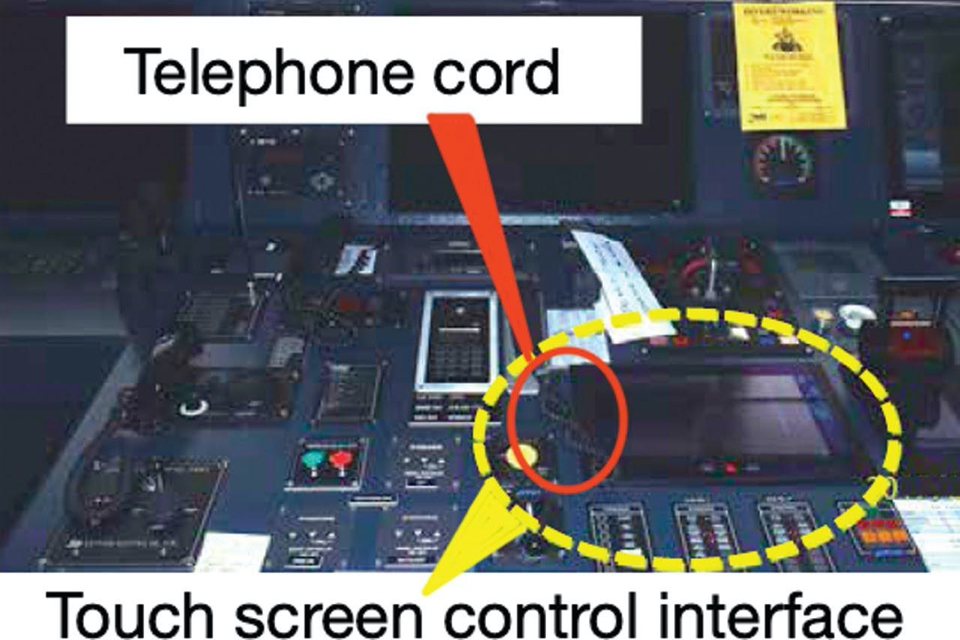Touchscreen interfaces on control panels are raising new issues when it comes to vessel control. In recent Mars Reports, one ship lost engine power and subsequently grounded after accidental activation of the engine shutdown command on the touchscreen. In another, a dredger lost its cargo when the hull accidentally opened.
The Mars reports are compiled (anonymously) by The Nautical Institute to prevent other accidents from happening. A summary of the first incident:
Staff on an up-bound tanker in a river waterway decided to anchor the vessel just below the lock to wait for traffic ahead to clear.
While it was anchoring the vessel lost propulsion. The master immediately contacted the engine room crew, who requested that propulsion control be transferred to the engine room. This would allow them to attempt to restart the engine. As the engine room crew were working to restart the main engine, the port bow anchor was remotely released from the bridge.
Despite these efforts, the vessel grounded. Although the main engine was soon restarted and propulsion control was transferred back to the bridge, attempts to free the vessel under power were unsuccessful. Two days later the vessel was refloated with the assistance of two tugs and towed to a nearby dock. Subsequent underwater inspection showed there was no apparent damage to the vessel.
Reactive to a telephone cord
The investigation found that the main engine shutdown feature on the touchscreen integrated alarm monitoring and control system had inadvertently been activated. The touchscreen was mounted horizontally in the centre bridge console, close to other controls such as steering and propulsion. At the time of the loss of propulsion, four crew members were within two metres of the touchscreen. Tests showed that the touchscreen was reactive to a variety of inputs – including the telephone cord situated next to it.
When the main engine shutdown button was activated on the touchscreen, a generic and ambiguous system status message appeared on the screen. The message did not specify that the engine was about to shut down, nor did it indicate how the shutdown was activated or from where (bridge, engine room, emergency stop etc).
Shutdown function disabled
A plastic cover was placed over the touchscreen to prevent another inadvertent shutdown. After a thorough review, the equipment manufacturer disabled the main engine shutdown function on the touchscreen and the plastic cover was removed. In case of an emergency, the main engine can still be shut down from the bridge via the traditional shutdown button.
Dredger accidentally loses cargo
The following happened in a second incident:
A small split-hull suction dredger was fully loaded and on its way to the dumping ground. The vessel was on autopilot and the duty seaman decided to dust the wheelhouse consoles. The vessel, still making way, was close to the dumping ground but not yet in position when the hull opened unexpectedly and the dredged material was prematurely released.
The investigation found that the ‘virtual button’ on the touchscreen control panel for the emergency open had been activated by the operator while he was dusting the screen. This button was only one level deep in the touchscreen menu control. Two unintended touches with the duster, one to reveal the ‘emergency opening’ button and one to activate it, had opened the vessel.
Advice from The Nautical Institute
- In order to use shipboard equipment effectively, crews must know how to operate that equipment during routine and emergency situations.
- In this case, given that the screen controlled the vessel’s integrated alarm monitoring and control system, it was especially important for crew members to familiarise themselves with the sensitivity level of the screen and the lack of any confirmation message after any action was taken using it.
- For touchscreen applications on control panels, procedures and protections should be implemented to protect against unwanted activations and their consequences.
Mars Reports
This accident was covered in the Mars Reports, originally published as Mars 202003 and 202004, that are part of Report Number 327. A selection of this Report has also been published in SWZ|Maritime’s February issue. The Nautical Institute compiles these reports to help prevent maritime accidents. That is why they are also published on SWZ|Maritime’s website.
More reports are needed to keep the scheme interesting and informative. All reports are read only by the Mars coordinator and are treated in the strictest confidence. To submit a report, please use the Mars report form.








